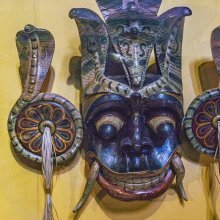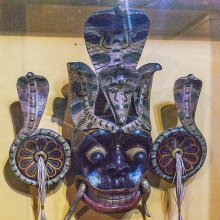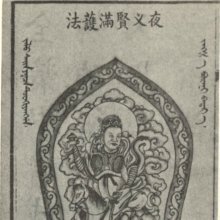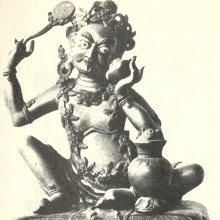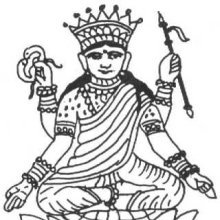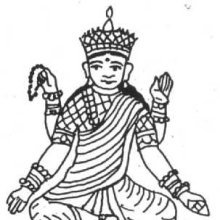Yaksha, Yakṣa, Yāksā: 46 definitions
Introduction:
Yaksha means something in Buddhism, Pali, Hinduism, Sanskrit, Jainism, Prakrit, the history of ancient India, Marathi, Hindi. If you want to know the exact meaning, history, etymology or English translation of this term then check out the descriptions on this page. Add your comment or reference to a book if you want to contribute to this summary article.
The Sanskrit term Yakṣa can be transliterated into English as Yaksa or Yaksha, using the IAST transliteration scheme (?).
Images (photo gallery)
(+38 more images available)
In Hinduism
Dharmashastra (religious law)
Source: Google Books: Manusmṛti with the ManubhāṣyaYakṣa (यक्ष) and the rest (rākṣasas and piśāca) are lower classes of beings, ignorant of the law relating to what should and what should not be eaten; and it is they that eat meat (See the Manubhāṣya verse 11.95)
Source: archive.org: The religion and philosophy of the Veda and the Upanishads (dharmashastra)Yakṣa (यक्ष) is the name of a deity to be invoked in a certain ritual, according to the Mānavagṛhyasūtra 2.14. Accordingly, the deity is prescribed when one suffers from possession by the Vināyakas, Śālakaṭaṅkaṭa, Kūṣmāṇḍarājaputra, Usmita and Devayajana. The Baijavāpagṛhyasūtra replaces the names of last two vināyakas with Mita and Sammita. According to R. C. Hazra in his Gaṇapati-worship, “this rite is both expiatory and propitiatory in nature and in which various things including meat and fish (both raw and cooked) and wine and cakes are to be offered”..
The gṛhya-sūtras are a branch of dharma-sūtras and refer to a category of Vedic literature dealing with domstic rites and rituals. The Mānava-gṛhya-sūtra belongs to the Kṛṣṇa-yajurveda. The Baijavāpa-gṛhya-sūtra is known only through references to it in other works (e.g., Vīramitrodaya-Saṃskāra).

Dharmashastra (धर्मशास्त्र, dharmaśāstra) contains the instructions (shastra) regarding religious conduct of livelihood (dharma), ceremonies, jurisprudence (study of law) and more. It is categorized as smriti, an important and authoritative selection of books dealing with the Hindu lifestyle.
Natyashastra (theatrics and dramaturgy)
Source: Wisdom Library: Nāṭya-śāstra1) Yakṣa (यक्ष) is a Sanskrit word referring to a group of deities. Acording to the Nāṭyaśāstra 1.88-94, when Brahmā, Indra and all other gods went to inspect the playhouse (nāṭyamaṇḍapa) designed by Viśvakarmā, he assigned different deities for the protection of the playhouse itself, as well as for the objects relating to dramatic performance (prayoga).
As such, Brahmā assigned the Yakṣas, the Bhūtas, the Piśācas and the Guhyakas to the pillars of the Mattavāraṇī (two side corridors of the stage used for peripheral acting or partial entry/exit). He also assigned the Yakṣas, the Guhyakas and the Pannagas underneath the stage (raṅgapīṭha). The protection of the playhouse was enacted because of the jealous Vighnas (malevolent spirits), who began to create terror for the actors.
2) Yakṣas are to be worshipped during raṅgapūjā, according to the Nāṭyaśāstra 3.1-8. Accordingly, the master of the dramatic art who has been initiated for the purpose shall consecrate the playhouse after he has made obeisance (e.g., to Yakṣas).
Source: archive.org: Natya ShastraYakṣa (यक्ष).—Description of a women of yaksa type;—A woman who sweats during sleep, loves quiet rest in bed or seat, is very intelligent, fearless and fond of wine, sweet scent and meat, takes delight on seeing the beloved one after a long time, feels gratitude to him, does not sleep for a long time, is said to have the nature of a yaksa.

Natyashastra (नाट्यशास्त्र, nāṭyaśāstra) refers to both the ancient Indian tradition (shastra) of performing arts, (natya—theatrics, drama, dance, music), as well as the name of a Sanskrit work dealing with these subjects. It also teaches the rules for composing Dramatic plays (nataka), construction and performance of Theater, and Poetic works (kavya).
Purana and Itihasa (epic history)
Source: Wisdom Library: Skanda-puranaYakṣa (यक्ष, “demigod-form”) refers to one of the fifty-six vināyakas located at Kāśī (Vārāṇasī), and forms part of a sacred pilgrimage (yātrā), described in the Kāśīkhaṇḍa (Skanda-purāṇa 4.2.57). He is also known as Yakṣavināyaka, Yakṣagaṇeśa and Yakṣavighneśa. These fifty-six vināyakas are positioned at the eight cardinal points in seven concentric circles (8x7). They center around a deity named Ḍhuṇḍhirāja (or Ḍhuṇḍhi-vināyaka) positioned near the Viśvanātha temple, which lies at the heart of Kāśī, near the Gaṅges. This arrangement symbolises the interconnecting relationship of the macrocosmos, the mesocosmos and the microcosmos.
Yakṣa is positioned in the Western corner of the sixth circle of the kāśī-maṇḍala. According to Rana Singh (source), his shrine is located at “Kotwalpura, CK 37 / 29”. Worshippers of Yakṣa will benefit from his quality, which is defined as “together with Sṛṣṭi, provides wealth and peace”. His coordinates are: Lat. 25.18667, Lon. 83.00545 (or, 25°11'12.0"N, 83°00'19.6"E) (Google maps)
Yakṣa, and the other vināyakas, are described in the Skandapurāṇa (the largest of the eighteen mahāpurāṇas). This book narrates the details and legends surrounding numerous holy pilgrimages (tīrtha-māhātmya) throughout India. It is composed of over 81,000 metrical verses with the core text dating from the before the 4th-century CE.
Source: archive.org: Puranic EncyclopediaYakṣa (यक्ष).—General. A class of Semi-gods. There are chiefly three classes of inhabitants in Heaven:—Devas, Gaṇadevas and Upadevas. Gaṇadevas consist of the 12 Ādityas, 10 Viśvadevas, 8 Vasus, 36 Tuṣitas, 64 Ābhāsvaras, 49 Anilas 220 Mahārājikas, 12 Sādhyas and 11 Rudras.
Among the Upadevas there are 10 subdivisions. They are, Vidyādharas, Apsaras, Yakṣas, Rākṣasas, Gandharvas, Kinnaras, Piśācas, Guhyakas, Siddhas and Bhūtas. Origin. There are different views relating to the origin of the Yakṣas. In Mahābhārata, Ādi Parva, Chapter l we find that the Yakṣas took birth after Brahmā’s birth from "Virāṭ Puruṣa's" aṇḍa. According to a statement in Agni Purāṇa, Chapter 19, Yakṣas and Rākṣasas were born from Munī, the grand daughter of Kaśyapaprajāpati. Thus Yakṣas and Rākṣasas are related as brothers. In Mahābhārata, Ādi Parva, Chapter 66, Verse 7, there is another passage which says that Yakṣas are the progeny of the sage Pulastya. Other details.
i) Once Śukadeva sang the story of Mahābhārata to the Yakṣas. (Mahābhārata Ādi Parva, Chapter 1, Verse 108).
(ii) Lakhs of Yakṣas remain in Kubera’s assembly, worshipping him. (Mahābhārata Sabhā Parva, Chapter 10, Verse 18).
(iii) There are Yakṣas in Brahmā’s assembly also. (Mahābhārata Sabhā Parva, Chapter 11, Verse 56).
(iv) Kubera is the King of Yakṣas. (Mahābhārata Vana Parva, Chapter 111, Verse 10).
(v) Bhīmasena once drove away Yakṣas and Rākṣasas. (Mahābhārata Vana Parva, Chapter 16, Verse 57).
(vi) On another occasion, Sunda and Upasunda defeated and persecuted the Yakṣas. (Mahābhārata Vana Parva, Chapter 208, verse 7). (See full article at Story of Yakṣa from the Puranic encyclopaedia by Vettam Mani)
Source: archive.org: Shiva Purana - English TranslationYakṣa (यक्ष) are a class of semi-divine beings who are attached to the service of Kubera.
Source: Cologne Digital Sanskrit Dictionaries: The Purana Index1a) Yakṣa (यक्ष).—A Rākṣasa and a son of Khaśā. As he wanted to eat his own mother, he got the name of Yakṣa; of four hands and four feet, a fearful figure wandering in the night in search of prey; took the form of Vasuruci and lived with the apsaras Krathusthalā in Nandana; she bore him a son Rajatanābha; went home in the Himālayas with the son, when Krathusthalā came to know of his birth as a Rākṣasa.*
- * Brahmāṇḍa-purāṇa III. 7. 60, 100-17; 22. 14; 41. 30; 71. 111; Vāyu-purāṇa 69. 160, 167.
1b) A son of Gāndinī.*
- * Vāyu-purāṇa 96. 110.
1c) A semi-celestial group, usually of the class of demons; born of Viśvā and Kaśyapa;1 followers of Rudra (Śiva), their overlord; their lord, Kubera;2 milked the cowearth, with Vaiśravaṇa as the calf and āma as the vessel;3 worship the Barhiṣad manes;4 helped Vṛtra against Indra and went with Satī to Dakṣa's sacrifice;5 sport of;6 got mokṣa meditating on Hari;7 usurped the Ānarta kingdom of Kakudmi when he was absent at Brahmā's court;8 came with the gods to see Kṛṣṇa and saw Kṛṣṇa retiring to his own region;9 (see Puṇyajanas); vanquished by Rāvaṇa;10 worship the Pitṛs and ruin the śrāddha;11 their kingdom;12 their loka;13 the nails of Vāmana when he grew.14
- 1) Bhāgavata-purāṇa II. 6. 13; VI. 8. 24; X. 6. 27; 62. 19; 85. 41; Brahmāṇḍa-purāṇa II. 32. 1-2; 35. 191; 36. 118; Matsya-purāṇa 6. 46.
- 2) Bhāgavata-purāṇa IV. 10. 5; XI. 16. 16; 23. 24; Matsya-purāṇa 8. 5.
- 3) Ib. 10. 22.
- 4) Ib. 15. 4.
- 5) Bhāgavata-purāṇa VI. 10. 20; IV. 4. 4, 34.
- 6) Ib. X. 90. 9.
- 7) Ib. VII. 7. 50.
- 8) Ib. IX. 3. 36.
- 9) Ib. VII. 8. 38; XI. 31. 2.
- 10) Brahmāṇḍa-purāṇa III. 7. 255.
- 11) Ib. III. 10. 38, 111; 11. 81; IV. 2. 26; 14. 4; 20. 50; 30. 9; 33. 75.
- 12) Matsya-purāṇa 23. 39; 121. 48.
- 13) Brahmāṇḍa-purāṇa IV. 39. 56.
- 14) Matsya-purāṇa 246. 54.
Yakṣa (यक्ष) is a name mentioned in the Mahābhārata (cf. I.59.7, I.65, I.61.1) and represents one of the many proper names used for people and places. Note: The Mahābhārata (mentioning Yakṣa) is a Sanskrit epic poem consisting of 100,000 ślokas (metrical verses) and is over 2000 years old.

The Purana (पुराण, purāṇas) refers to Sanskrit literature preserving ancient India’s vast cultural history, including historical legends, religious ceremonies, various arts and sciences. The eighteen mahapuranas total over 400,000 shlokas (metrical couplets) and date to at least several centuries BCE.
Vaishnavism (Vaishava dharma)
Source: Pure Bhakti: Bhagavad-gita (4th edition)Yakṣa (यक्ष) refers to “ghost, or spirit”. (cf. Glossary page from Śrīmad-Bhagavad-Gītā).

Vaishnava (वैष्णव, vaiṣṇava) or vaishnavism (vaiṣṇavism) represents a tradition of Hinduism worshipping Vishnu as the supreme Lord. Similar to the Shaktism and Shaivism traditions, Vaishnavism also developed as an individual movement, famous for its exposition of the dashavatara (‘ten avatars of Vishnu’).
Shaivism (Shaiva philosophy)
Source: SOAS University of London: Protective Rites in the Netra TantraYakṣa (यक्ष) refers to a “group of supernatural beings” that cause illness, according to the Netratantra of Kṣemarāja: a Śaiva text from the 9th century in which Śiva (Bhairava) teaches Pārvatī topics such as metaphysics, cosmology, and soteriology.—The Netratantra’s Second Chapter begins with the goddess Pārvatī’s request that Śiva reveal to her the remedy for the ailments that afflict divine and worldly beings. [...]. Śiva adds to the list of maladies a group of supernatural beings that cause illness: [e.g., Yakṣas], [...]. That Śiva discusses supernatural beings that cause such disease demonstrates how invisible forces affect the world in observable ways. In order to counter these forces, Śiva reveals another invisible but observable element, mantra.
Yakṣa is mentioned in a list of afflictions (which does not arise in the place and time of the Mantravid), according to verse 19.129-133.

Shaiva (शैव, śaiva) or Shaivism (śaivism) represents a tradition of Hinduism worshiping Shiva as the supreme being. Closely related to Shaktism, Shaiva literature includes a range of scriptures, including Tantras, while the root of this tradition may be traced back to the ancient Vedas.
Shilpashastra (iconography)
Source: Shodhganga: Elements of Art and Architecture in the Trtiyakhanda of the Visnudharmottarapurana (shilpa)Yakṣa (यक्ष) refers to a certain class of personalities which follows specific guidelines in the tradition of ancient Indian Painting (citra), according to the Viṣṇudharmottarapurāṇa, an ancient Sanskrit text which (being encyclopedic in nature) deals with a variety of cultural topics such as arts, architecture, music, grammar and astronomy.—In the Viṣṇudharmottarapurāṇa, the rules of Painting of different classes have been elaborately discussed. According to this work, Yakṣas should have the size of rucaka and the picture of Pradhāna and Mānava should be painted according to the size of śaśaka types of men. The Yakṣas and the Kinnaras presuppose a divine connection in their birth. The picture of the wives of Daityas, Dānavas, Yakṣas and Rākṣasas should be very beautiful. Thus the Viṣṇudharmottarapurāṇa establishes the fact that even in the pictures; the people belonging to different class and profession [e.g., Kinnara] were projected with specific attire so that general people can equate the picture with the practical character.

Shilpashastra (शिल्पशास्त्र, śilpaśāstra) represents the ancient Indian science (shastra) of creative arts (shilpa) such as sculpture, iconography and painting. Closely related to Vastushastra (architecture), they often share the same literature.
General definition (in Hinduism)
Source: Wisdom Library: HinduismYakṣa (यक्ष):—In Vedic hinduism, the Yakṣas represent a group of mysterious beings, with Kubera as their chief. They are also known as Guhyaka (‘the secret-ones’) and are often associated with Rākṣasas (‘the night-wanderers’) and Nāgas (‘serpents’). Kubera is the Vedic God of wealth presiding over all earthly treasures.
Source: Apam Napat: Indian MythologyYakshas are sometimes considered to be a class of the Gandharvas, but are definitely of a more malevolent disposition. They are the sons of the sage Kashyapa and Khasa. In many stories, they harrass mortals, chiefly by enchanting forests, lakes and rivers and killing any human who ventures near them.
They are more closely related to the Asuras because of their dark deeds. They are not immortal, and definitely not worshipped. They are mostly the enemies of mankind. They are very long lived and possess magical powers, although they can be defeated by men without magic.
The Yakshas are said to be very wealthy. Their king Kubera is said to be the wealthiest of all beings.
Source: WikiPedia: HinduismYaksha is the name of a broad class of nature-spirits, usually benevolent, who are caretakers of the natural treasures hidden in the earth and tree roots. They appear in Hindu, Jain and Buddhist mythology. In Hindu, Jain, and Buddhist mythology, the yakṣa has a dual personality. On the one hand, a yakṣa may be an inoffensive nature-fairy, associated with woods and mountains; but there is also a darker version of the yakṣa, which is a kind of ghost (bhuta) that haunts the wilderness and waylays and devours travelers, similar to the rakṣasas.
In Buddhism
Theravada (major branch of Buddhism)
Source: Pali Kanon: Manual of Buddhist Terms and Doctrinesin popular belief, a kind of ghost, goblin or ogre. See Yakkha.
Theravāda is a major branch of Buddhism having the the Pali canon (tipitaka) as their canonical literature, which includes the vinaya-pitaka (monastic rules), the sutta-pitaka (Buddhist sermons) and the abhidhamma-pitaka (philosophy and psychology).
Mahayana (major branch of Buddhism)
Source: Wisdom Library: Maha Prajnaparamita SastraYakṣa (यक्ष) according to the 2nd century Mahāprajñāpāramitāśāstra (chapter XX). Accordingly, “he knows that a jealous man who loves to dispute but who can give fine houses (gṛha), beds and seats (śayāsana), clothing (vastra) and food (āhāra), will be reborn among the Yakṣas who fly about in palaces and temples where they enjoy all kinds of pleasures and material advantages”.
Yakṣas, together with other deities constitute the Asuras, according to chapter XLVI.—Accordingly, “great gods such as the Asuras, Kiṃnaras, Gandharvas, Kumbhāndas, Yakṣas, Rakṣasas, Bhūtas, etc., are Asuras, and when their troops increase, those of the Devas decrease. Their power (anubhāva) and their transformations (nirmāṇa) were exercised at will. The Asura destiny is called thus because the Asuras appear at the head of a list; the others, namely, the Kiṃnaras, Gandharvas, Kuṃbhāṇḍas, Yakṣas, Bhūtas, etc. constitute one and the same destiny with them”.
Source: City of 10,000 Buddhas: The Shurangama Sutra"Yaksha" is a Sanskrit word which means "speedy" (jie yi). It also means "courageous and strong" (yong jian). Yakshas are a kind of ghost. There are three main types of ghost:
- Earth-travelling ghosts;
- Flying ghosts;
- Space-travelling ghosts.

Mahayana (महायान, mahāyāna) is a major branch of Buddhism focusing on the path of a Bodhisattva (spiritual aspirants/ enlightened beings). Extant literature is vast and primarely composed in the Sanskrit language. There are many sūtras of which some of the earliest are the various Prajñāpāramitā sūtras.
Tibetan Buddhism (Vajrayana or tantric Buddhism)
Source: Wisdom Library: Tibetan Buddhism1) Yakṣa (यक्ष) refers to a group of deities mentioned as attending the teachings in the 6th century Mañjuśrīmūlakalpa: one of the largest Kriyā Tantras devoted to Mañjuśrī (the Bodhisattva of wisdom) representing an encyclopedia of knowledge primarily concerned with ritualistic elements in Buddhism. The teachings in this text originate from Mañjuśrī and were taught to and by Buddha Śākyamuni in the presence of a large audience (including the Yakṣas).
2) Yakṣa (यक्ष) is also the name of a Rāśi (zodiac sign) mentioned as attending the teachings in the 6th century Mañjuśrīmūlakalpa.
Source: archive.org: The Indian Buddhist IconographyYakṣa (यक्ष) refers to a group of eight kings, commonly depicted in Buddhist Iconography, and mentioned in the 11th-century Niṣpannayogāvalī of Mahāpaṇḍita Abhayākara.—In the dharmadhātuvāgīśvara-maṇḍala eight Lords of Yakṣas are described briefly. This list of Yakṣa kings is important as it is not found elsewhere; it is not possible also to individualize them in their forms. The Yakṣas are a semi-mythical class of beings who are supposed to preside over treasures and shower wealth on mankind when propitiated. Kubera is said to be the greatest among the Yakṣas, who according to the Hindus, lives in the North along with the Yakṣa hordes. The name of his capital is said to be Alakāpuri adjacent to Mount Kailāsa in the Himalayan region.
he names of the eight Yakṣa kings are:
- Pūrṇabhadra,
- Māṇibhadra,
- Dhanada,
- Vaiśravaṇa,
- Civikuṇḍalī,
- Kelimalī,
- Sukhendra,
- Calendra.
1) Yakṣa (यक्ष) is the name of a Vīra (hero) who, together with the Ḍākinī named Yakṣī forms one of the 36 pairs situated in the Agnicakra, according to the 10th century Ḍākārṇava chapter 15. Accordingly, the agnicakra refers to one of the three divisions of the saṃbhoga-puṭa (‘enjoyment layer’), situated in the Herukamaṇḍala. The 36 pairs of Ḍākinīs and Vīras [viz., Yakṣa] are red in color; they each have one face and four arms; they hold a skull bowl, a skull staff, a small drum, and a knife.
2) Yakṣa (यक्ष) is the name of a Vīra (hero) who, together with the Ḍākinī named Yakṣiṇī forms one of the 36 pairs situated in the Cittacakra, according to the 10th century Ḍākārṇava chapter 15. Accordingly, the cittacakra refers to one of the three divisions of the nirmāṇa-puṭa (‘emanation layer’), situated in the Herukamaṇḍala. The 36 pairs of Ḍākinīs and Vīras [viz., Yakṣa] are black in color; they each have one face and four arms; they hold a skull bowl, a skull staff, a small drum, and a knife.

Tibetan Buddhism includes schools such as Nyingma, Kadampa, Kagyu and Gelug. Their primary canon of literature is divided in two broad categories: The Kangyur, which consists of Buddha’s words, and the Tengyur, which includes commentaries from various sources. Esotericism and tantra techniques (vajrayāna) are collected indepently.
General definition (in Buddhism)
Source: Wisdom Library: BuddhismYaksha:—A type of demon who now protects Buddhism.
Source: Buddhist Door: GlossaryThe demons in the lower realm, like the Ghost Realm. They are evil, malignant and violent. They live on earth or in air.
Source: WikiPedia: BuddhismIn Buddhist literature, the yakṣa are the attendants of Vaiśravaṇa, the Guardian of the Northern Quarter, a beneficent god who protects the righteous. The term also refers to the Twelve Heavenly Generals who guard Bhaiṣajyaguru, the Medicine Buddha.
According to the Mahavamsa, Prince Vijaya encountered the royalty of the Yakkhas. King Maha Kalasena, Queen Gonda on the celebration of the marriage of their daughter Princess Polamitta in the Yakkha capital of Lankapura and conquered them. Lankapura may have been in Arithra or Vijithapura. The Yakkhas served as loyal subjects with the Vijiyan dynasty and the Yakkha chieftain sat on equal height to the Sri Lankan leaders on festival days.
In Jainism
General definition (in Jainism)
Source: Wisdom Library: Jainism1) Yakṣa (यक्ष) is the shorter name of Yakṣadvīpa, one of the continents (dvīpa) of the middle-world (madhyaloka) which is encircled by the ocean named Yakṣasamudra (or simply Yakṣa), according to Jain cosmology. The middle-world contains innumerable concentric dvīpas and, as opposed to the upper-world (adhaloka) and the lower-world (ūrdhvaloka), is the only world where humans can be born.
Yakṣa is recorded in ancient Jaina canonical texts dealing with cosmology and geography of the universe. Examples of such texts are the Saṃgrahaṇīratna in the Śvetāmbara tradition or the Tiloyapannatti and the Trilokasāra in the Digambara tradition.
2) Yakṣa (यक्ष).—The yakṣas are a group of deities categorised as belonging to the vyantara class of Gods (devas). Their color is black and their tree is the “banyan tree” (vaṭa).
There are twelve types of yakṣas in Jaina cosmology:
- Maṇibhadra,
- Pūrṇabhadra,
- Śailabhadra,
- Manobhadra,
- Bhadraka,
- Subhadraka,
- Sarvabhadra,
- Manuṣya,
- Dhanapāla,
- Svarūpaka,
- Yakṣottama,
- Manohārin.
The vyantaras represent a class of Gods (devas) comprising eight groups of deities that wander about the three worlds (adhaloka, madhyaloka and ūrdhvaloka).
2) Yakṣa (यक्ष) refers to a class of piśāca deities according to the Digambara tradition of Jainism, while Śvetāmbara does not recognize this class. The piśācas refer to a category of vyantaras gods which represents one of the four classes of celestial beings (devas).
The deities such as the Yakṣas are defined in ancient Jain cosmological texts such as the Saṃgrahaṇīratna in the Śvetāmbara tradition or the Tiloyapaṇṇati by Yativṛṣabha (5th century) in the Digambara tradition.
Source: Google Books: Jaina IconographyYakṣa (यक्ष).—A class of vyantara gods;—According to the Tiloyapaṇṇatti, they are divided into 12 kinds:
- Maṇibhadra,
- Pūrṇabhadra,
- Śailabhadra,
- Manobhadra,
- Bhadraka,
- Subhadra,
- Sarvabhadra,
- Mānuṣa,
- Dhanapāla,
- Sarūpa,
- Yakṣottama,
- Manoharaṇa.
Their Caitya-tree is the Banyan tree.
According to the Śvetāmbaras, they are divided into 13 groups:
- Pūrṇabhadra,
- Maṇibhadra,
- Śvetabhadra,
- Haritabhadra,
- Sumanobhadra,
- Vyatipātikabhadra,
- Subhadra,
- Sarvatobhadra,
- Mānuṣyapakṣa,
- Vanāhāra,
- Rūpayakṣa,
- Yakṣottama,
- Vanādhipati (Dhanādhipati in Saṃgrahaṇī).
They are beautiful to look at and possess well-proportioned limbs, serene in appearance, wearing shining kirīṭamukuṭas, and other ornaments. Black in complexion, they have the Banyan-tree on their dhvajas.
Source: archive.org: The Jaina IconographyYakṣa (यक्ष) together with the Yakṣī or Yakṣiṇī compose the Śāsanadevatās or “attending deities” of the Tīrthaṃkaras.—“A Yakṣa is a devotee of the Tīrthaṃkaras”, so defines a Jaina liturgical text. According to the Jaina belief, Indra appoints one Yakṣa and Yakṣī to serve, as attendants of each Tīrthaṃkara. The Yakṣa would be on his right side and Yakṣiṇī on his left. Thus, they also came to be called Śāsana-devatā or attendant spirits. According to Hemacandra, a Yakṣa originates from the particular religious spirit of a Jina. Hence, we can take, in all strong probability, that the Yakṣa was the leader of the disciples and Yakṣiṇī was the first female convert.
Source: Encyclopedia of Jainism: Tattvartha Sutra 4: The celestial beings (deva)Yakṣa (यक्ष) refers to the “treasure-keeper” class of “peripatetic celestial beings” (vyantara), itself a category of devas (celestial beings), according to the 2nd-century Tattvārthasūtra 4.10. Who are the lords amongst the treasure-keeper (yakṣa) class of peripatetic (forest) celestial beings? Pūrṇabhadra and Maṇibhadra are the two lords in the treasure-keeper peripatetic celestial beings.

Jainism is an Indian religion of Dharma whose doctrine revolves around harmlessness (ahimsa) towards every living being. The two major branches (Digambara and Svetambara) of Jainism stimulate self-control (or, shramana, ‘self-reliance’) and spiritual development through a path of peace for the soul to progess to the ultimate goal.
India history and geography
Source: Cologne Digital Sanskrit Dictionaries: Indian Epigraphical GlossaryYakṣa.—(CII 4; HA), a semi-divine being; a demi-god belonging to the class of vyantara-devatās according to Jain mythology. Note: yakṣa is defined in the “Indian epigraphical glossary” as it can be found on ancient inscriptions commonly written in Sanskrit, Prakrit or Dravidian languages.
Source: Singhi Jain Series: Ratnaprabha-suri’s Kuvalayamala-katha (history)Yakṣa (यक्ष) refers to one of the deities being worshiped in ancient India, as vividly depicted in the Kathās (narrative poems) such as Uddyotanasūri in his 8th-century Kuvalayamālā (a Prakrit Campū, similar to Kāvya poetry).—The Kuvalayamala (779 A.D.) is full of cultural material which gains in value because of the firm date of its composition. [...] Page 256.31-2 ff.: Here is a mixed list of 25 gods and Godlings of all religions. These were worshipped and propitiated to obtain favours. The list includes [e.g., Yakṣa] [...].
Source: Academia: Ritual Period: A Comparative Study of Three Newar Buddhist Menarche ManualsYakṣa (यक्ष) refers to “vegetable spirits”, according to the “Vādhā byaṃ ke vidhi”: the name of two manuscripts written by (1) Kathmandu-based priest, Badriratna Bajracharya and (2) Buddharatna Bajracharya from Lalitpur.—Badriratna’s text pays the most attention to the invocations of celestial bodies and other cosmologically grouped agents. The list consists of [e.g., vegetable spirits (yakṣas)]. In this list, we particularly find the dark forces that are especially adept at causing problems for women, children and, more specifically, girl children, addressed and harnessed.

The history of India traces the identification of countries, villages, towns and other regions of India, as well as mythology, zoology, royal dynasties, rulers, tribes, local festivities and traditions and regional languages. Ancient India enjoyed religious freedom and encourages the path of Dharma, a concept common to Buddhism, Hinduism, and Jainism.
Languages of India and abroad
Marathi-English dictionary
Source: DDSA: The Molesworth Marathi and English Dictionaryyakṣa (यक्ष).—m (S) A class of demigods or minor deities, or an individual of it. They are employed esp. in the care of the gardens and treasures of kubēra.
Source: DDSA: The Aryabhusan school dictionary, Marathi-Englishyakṣa (यक्ष).—m A class of demigods. yakṣiṇī f A female of the class of demigods.
Marathi is an Indo-European language having over 70 million native speakers people in (predominantly) Maharashtra India. Marathi, like many other Indo-Aryan languages, evolved from early forms of Prakrit, which itself is a subset of Sanskrit, one of the most ancient languages of the world.
Sanskrit dictionary
Source: DDSA: The practical Sanskrit-English dictionaryYakṣa (यक्ष).—[yakṣyate, yakṣ-karmaṇi ghañ]
1) Name of a class of demigods who are described as attendants of Kubera, the god of riches, and employed in guarding his gardens and treasures; यक्षोत्तमा यक्षपतिं धनेशं रक्षन्ति वै प्रासगदादिहस्ताः (yakṣottamā yakṣapatiṃ dhaneśaṃ rakṣanti vai prāsagadādihastāḥ) Hariv.; Meghadūta 68; Bhagavadgītā (Bombay) 1.23;11.22.
2) A kind of ghost or spirit; तन्न व्यजानन्त किमिदं यक्षमिति (tanna vyajānanta kimidaṃ yakṣamiti) Ken.3.2.
3) Name of the palace of Indra.
4) Name of Kubera.
5) Worship.
6) A dog.
-kṣam 1 A ghost.
2) Sacrifice.
3) Anything honoured.
-kṣī 1 A female Yakṣa.
2) Name of Kubera's wife.
3) The Yakṣa. class; अल्पवीर्या यदा यक्षी श्रूयते मुनिपुंगव (alpavīryā yadā yakṣī śrūyate munipuṃgava) Rām.1.25.2.
Derivable forms: yakṣaḥ (यक्षः).
Source: Cologne Digital Sanskrit Dictionaries: Edgerton Buddhist Hybrid Sanskrit DictionaryYakṣa (यक्ष).—(as in Sanskrit): (1) mahāntaṃ yakṣaṃ, applied to Māra: Mahāvastu ii.260.10; 261.11. Cf. yakkha, applied to Māra, Sn 449 (seems to be a rare use in Pali); (2) name of a rākṣasa king: (Ārya-)Mañjuśrīmūlakalpa 18.1.
Source: Cologne Digital Sanskrit Dictionaries: Shabda-Sagara Sanskrit-English DictionaryYakṣa (यक्ष).—m.
(-kṣaḥ) 1. A demi-god, attendant especially on Kuvera, and employed in the care of his gardens and treasures. 2. A name of Kuvera. 3. The residence of Indra. f. (-kṣī) The wife of Kuvera. E. yakṣ to worship, aff. ghañ.
Source: Cologne Digital Sanskrit Dictionaries: Benfey Sanskrit-English DictionaryYakṣa (यक्ष).— (vb. yaj), I. m. 1. A kind of demigod, attendant on Kuvera,
Yakṣa (यक्ष).—[neuter] a supernatural being or apparition, ghost, spirit; [masculine] a class of genii, attendants on Kubera ([feminine] ī); [abstract] tā† [feminine], tva† [neuter]
Source: Cologne Digital Sanskrit Dictionaries: Monier-Williams Sanskrit-English Dictionary1) Yakṣa (यक्ष):—[from yakṣ] n. a living supernatural being, spiritual apparition, ghost, spirit, [Ṛg-veda; Atharva-veda; Vājasaneyi-saṃhitā; Brāhmaṇa; Gṛhya-sūtra and śrauta-sūtra] ([according to] to some native Comms. = yajña, pujā, pūjita etc.)
2) [v.s. ...] m. Name of a class of semi-divine beings (attendants of Kubera, exceptionally also of Viṣṇu; described as sons of Pulastya, of Pulaha, of Kaśyapa, of Khasā or Krodhā; also as produced from the feet of Brahmā; though generally regarded as beings of a benevolent and inoffensive disposition, like the Yakṣa in Kālidāsa’s Megha-dūta, they are occasionally classed with Piśācas and other malignant spirits, and sometimes said to cause demoniacal possession; as to their position in the Buddhist system See, [Monier-Williams’ Buddhism 206, 218]), [Upaniṣad; Gṛhya-sūtra; Manu-smṛti; Mahābhārata] etc.
3) [v.s. ...] (with Jainas) a subdivision of the Vyantaras
4) [v.s. ...] Name of Kubera, [Varāha-mihira’s Yogayātrā]
5) [v.s. ...] of a Muni, [Rāmāyaṇa]
6) [v.s. ...] of a son of Śvaphalka, [Viṣṇu-purāṇa]
7) [v.s. ...] of Indra’s palace, [cf. Lexicographers, esp. such as amarasiṃha, halāyudha, hemacandra, etc.]
8) [v.s. ...] a dog, [cf. Lexicographers, esp. such as amarasiṃha, halāyudha, hemacandra, etc.]
9) Yakṣā (यक्षा):—[from yakṣa > yakṣ] f. Name of a woman, [Hemacandra’s Pariśiṣṭaparvan]
10) Yākṣa (याक्ष):—mf(ī)n. ([from] yakska) belonging or peculiar to the Yakṣas, [Sāṃkhyakārikā [Scholiast or Commentator]]
Source: Cologne Digital Sanskrit Dictionaries: Yates Sanskrit-English DictionaryYakṣa (यक्ष):—(kṣaḥ) 1. m. A demigod attendant on Kuvera; Kuvera; residence of Indra. f. (kṣī) Kuvera's wife.
Source: DDSA: Paia-sadda-mahannavo; a comprehensive Prakrit Hindi dictionary (S)Yakṣā (यक्षा) in the Sanskrit language is related to the Prakrit word: Jakkhā.
[Sanskrit to German]
Sanskrit, also spelled संस्कृतम् (saṃskṛtam), is an ancient language of India commonly seen as the grandmother of the Indo-European language family (even English!). Closely allied with Prakrit and Pali, Sanskrit is more exhaustive in both grammar and terms and has the most extensive collection of literature in the world, greatly surpassing its sister-languages Greek and Latin.
Hindi dictionary
Source: DDSA: A practical Hindi-English dictionaryYakṣa (यक्ष) [Also spelled yaksh]:—(nm) a class of mythological demi-gods; ~[nāyaka/pati] Kuber—the chief of yakshas and the god of wealth.
...
Kannada-English dictionary
Source: Alar: Kannada-English corpusYakṣa (ಯಕ್ಷ):—
1) [noun] a class of Hindu, jaina or buddhist demi-gods.
2) [noun] Kubēra, the head of this class.
3) [noun] an evil spiit; a devil; a goblin.
Kannada is a Dravidian language (as opposed to the Indo-European language family) mainly spoken in the southwestern region of India.
Nepali dictionary
Source: unoes: Nepali-English Dictionary1) Yakṣa (यक्ष):—n. 1. Mythol. a class of ancient life-energy deities; ordinarily associated with vegetation; particularly trees; 2. a title of Kubera; 3. one of the surnames within Rai community;
2) Yāksā (याक्सा):—n. farm house;
Nepali is the primary language of the Nepalese people counting almost 20 million native speakers. The country of Nepal is situated in the Himalaya mountain range to the north of India.
See also (Relevant definitions)
Starts with (+61): Yaksha-dvara, Yakshabali, Yakshabhavana, Yakshabhrit, Yakshadanta, Yakshadara, Yakshadasi, Yakshadatta, Yakshadeva, Yakshadevagriha, Yakshadhipa, Yakshadhipati, Yakshadhupa, Yakshadigvijaya, Yakshadrish, Yakshadvipa, Yakshagana, Yakshaganesha, Yakshagraha, Yakshagrahaparipidita.
Ends with (+155): Adhyaksha, Akshapatal-adhyaksha, Anadhyaksha, Antahpuradhyaksha, Antaradhyaksha, Antaryaksha, Apratyaksha, Aranyadhyaksha, Aryaksha, Ashvadhyaksha, Atyaksha, Ayudhadhyaksha, Baladhyaksha, Bhanda-adhyaksha, Bhavadhyaksha, Bhavapratyaksha, Bhumyayaksha, Bhuryaksha, Bijadhyaksha, Brahmayaksha.
Full-text (+1297): Manibhadra, Yaksharaj, Yakshini, Yakshamalaka, Yakshendra, Yaksharasa, Manicara, Purnabhadra, Puṇyajana, Mahayaksha, Mahasenavyuhaparakrama, Kubera, Gajakarna, Yakshadhipati, Yakshavasa, Yakshagraha, Yaksharaja, Purvayaksha, Prabalaka, Kasheraka.
Relevant text
Search found 164 books and stories containing Yaksha, Yakṣa, Yaksa, Yakṣā, Yākṣa, Yāksā; (plurals include: Yakshas, Yakṣas, Yaksas, Yakṣās, Yākṣas, Yāksās). You can also click to the full overview containing English textual excerpts. Below are direct links for the most relevant articles:
Garga Samhita (English) (by Danavir Goswami)
Verse 2.23.15 < [Chapter 23 - The Killing of Śaṅkhacūḍa During the Rāsa-dance Pastime]
Verse 2.23.19 < [Chapter 23 - The Killing of Śaṅkhacūḍa During the Rāsa-dance Pastime]
Verse 4.9.18 < [Chapter 9 - The Glories of Srī Ekādaśī]
Rig Veda (translation and commentary) (by H. H. Wilson)
Ramayana of Valmiki (by Hari Prasad Shastri)
Chapter 14 - The Combat between Ravana and the Yakshas < [Book 7 - Uttara-kanda]
Chapter 15 - The Combat between Ravana and Dhanada < [Book 7 - Uttara-kanda]
Chapter 25 - Vishvamitra seeks to convince Rama < [Book 1 - Bala-kanda]
Kena upanishad (Madhva commentary) (by Srisa Chandra Vasu)
Mantra 3.11 < [Book 3 - Tṛtīya-Khaṇḍa]
Mantra 3.6 < [Book 3 - Tṛtīya-Khaṇḍa]
Mantra 3.2 < [Book 3 - Tṛtīya-Khaṇḍa]
Lakulisha-Pashupata (Philosophy and Practice) (by Geetika Kaw Kher)
Sculptural Evidence < [Chapter 1 - The Historical Context]
Historicity (of the term linga) < [Chapter 6 - Siva-linga: an Iconological Study]
Kalamukhas: The politically organized Saivite ascetics < [Chapter 2 - Spread and Transition]
A Historical Study of Kaushambi (by Nirja Sharma)
Related products
